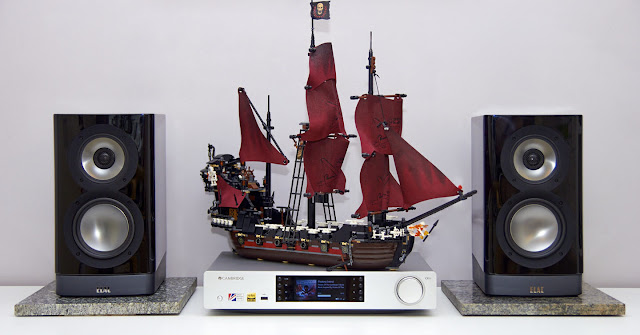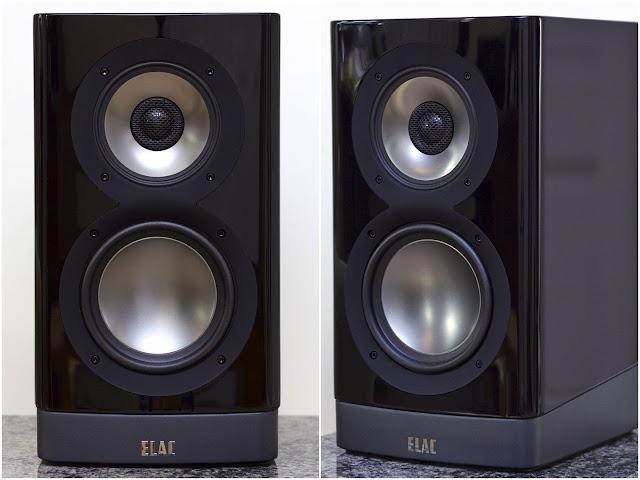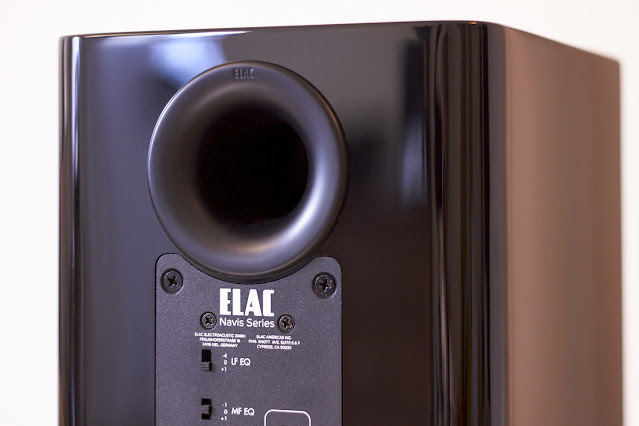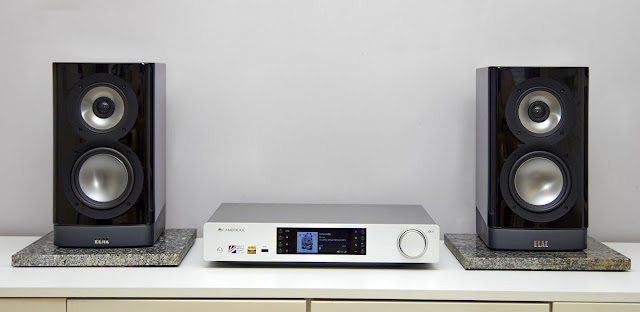Often, within a model series, bookshelf speakers are a stripped-down and somewhat compromise version of floor acoustics - but not in our case. In the Navis line, ELAC has demonstrated a special approach - ideologically and constructively, the ARB51 shelf stands differ little from the ARF51 floor stands. The difference in the height of the case and the number of woofers.
After testing the ARF51 floor modification, which I recommend reading for comparison when I got acquainted with the three-strip shelf version, I experienced deja vu literally at every step. Let's start at least with the exterior - cover the bottom part of the floor standers with two woofers and the remaining "top" will give you almost complete information about the design of the bookshelves.
For a home test, I was given a version in a glossy black MDF case with damped walls - its floor counterpart then seemed to me very strict and academic. However, now the speakers organically fit into the interior of different rooms, including the nursery with funny applications on the walls. However, in my case, the option in white gloss would be more appropriate. Also in the line, there is a design under a dark tree.
 |
| This is a "demo"-arrangement for visual illustration. During the test in another room, the speakers were placed on stands and turned towards the listener. |
The main similarity between floor and shelf modifications is hidden inside. In the small case of each speaker, there are three amplifiers at once - one per speaker and the company refers to the type of amplification as “pure analog”.
In fact, there is a bit of slyness here: a 40W true analog Class AB amplifier drives only a 2.5cm soft dome tweeter. The rest of the amplifiers are built according to the BASH AB (Bridged Amplifier Switching Hybrid) hybrid circuit, which is a development of the Canadian company Indigo.
This solution is well suited to the task of placing amplification units in a compact package with little heat generation. The output stages of such amplifiers are indeed built according to the AB scheme, but the signal is pre-processed similarly to the process in class D switching amplifiers.
The mid-range speaker works with a 100 W amplifier, and the woofer accounts for as much as 160 W, while at the floor speaker this power is distributed to three woofers at once.
 |
| In a small case, the developers placed three-way acoustics and three amplifiers |
For balanced sound at high and medium frequencies, as well as for the sake of maintaining the compact dimensions of the speakers, the developers used a combined design, placing a tweeter and a 10-cm aluminum midrange driver coaxially in a separate closed part of the case - the signal is separated by a crossover at around 2.2 kHz.
The 5.25-inch (13.34-cm) woofer is also made of aluminum - this material was chosen for the optimal combination of lightness, rigidity, and elasticity. Here the crossover is set to 260 Hz.
Remote Control
At the back, the AFB51 shelf speakers are also similar to floor speakers - only their lower part, and this time you need to mentally cover the two upper phase inverters, and under the lower one, there is exactly the same panel with toggle switches, switches, and connectors.
As in the previous test, I will connect a network player with the possibility of digital preamplification using balanced inputs. In this audition, the main source was an advanced Cambridge Audio CXN v2 player with a high-performance DSP and a dual Wolfson WM8740 DAC, which I connected to the speakers with an XLR Analysis-Plus Solo Crystal Oval analog interconnect cable.
The acoustics also has RCA connectors - Cold Ray Interconnect Line AG cables were prepared for them.
 |
| Among other control tools, the equalizer toggle switches were especially relevant, it’s a pity that they are inconvenient to switch while listening |
Navis speakers can also be connected wirelessly using the 2.4 GHz Wi-Fi protocol AirX². For this, the ELAC Navis Transmitter AIR-X2TW-BK transmitter is provided in the model line of the same name (purchased separately). A wide variety of devices are connected to this small black box via RCA connectors (and, if necessary, various adapters): a computer, smartphone, set-top box, and music center.
Inputs are switched by a separate small toggle switch on each column. Nearby is the Gain switch, which allows you to select the signal level. When working with balanced connectors, the Low mode was enough for me. If the speakers work in triphonics with a subwoofer, then, if necessary, you can set the low-frequency cut to 80 or 60 Hz with the HP filter switch. But, as it turned out, this is superfluous - even shelf speakers can perfectly do without additional bass.
But the three-band equalizer fit just right. Let me remind you that the Navis speakers have three switches for high, medium, and low frequencies that can add or subtract 1 dB in their range (only 4 dB is reduced for low frequencies). Looking ahead, I will say that the equalizer works delicately and does not introduce noticeable changes in the sound - just some nuances. However, when listening to this block, it turned out to be very useful.
Work in a team
For the test, I picked up vinyl hi-res rips, which I fed to the player via the USB connector on the front panel, and also used the Tidal service. In all cases, control was carried out through the branded Cambridge Connect application installed on an Android smartphone and on an iPad. The network player and speakers demonstrate that high-quality music files in high-resolution sound are noticeably better than streaming from Tidal - but this can only be detected by direct comparison.
Using a minijack to 2 RCA adapter, I tried to connect the LG V20 music smartphone through the headphone jack, as well as phones without a dedicated DAC - while the sound remained within acceptable limits. It can be assumed that compact headphone DAC amplifiers with an additional preamp function can work well with ELAC Navis speakers. So - this acoustics can be taken "for growth" to an existing portable, with the expectation of further acquisition of a more advanced source.
 |
| Tweeter and midrange driver are arranged coaxially for better sound consistency |
To connect a variety of audio devices, it was more convenient for me to use the ELAC Navis Transmitter AIR-X2TW-BK wireless signal transmitter, which, as stated, is capable of transmitting a signal with a resolution of 16 bit / 44 kHz with CD quality. For the sake of the experiment, using the same 3.5 mm adapter, I tried many options and even sent sound from an old cassette player to the speakers.
But the wireless connection should be considered as purely auxiliary because even paired with a high-quality external DAC, the Navis transmitter is inferior in sound to streaming from Tidal, transmitted to the speakers by the Cambridge player via a balanced output, not to mention the high-res from a USB flash drive - in particular, sent " through the air, the sound seemed a little muffled to me.
Under the click of tumblers
In the last test, related floor standers did a good job with peppy power metal - and I suggested that a 160-watt amplifier pumping the only woofer in the bookshelves would make the bass drier and faster. And so it turned out - in the DragonForce composition "Through the Fire and Flames" the speakers easily kept up with the machine-gun rhythm of guitars and bass drums.
In the song "Hunting High And Low" by Stratovarius, the same picture - the speakers clearly convey high-speed drive, while emphasizing vocals and filling the room with dense and not booming bass. Perhaps, true metalheads will prefer a harder sound, but the ARB51 has no obvious failures in this genre.
 |
| From experience, these shelves should be placed at least 40 cm from the wall, otherwise, the room responds with a hum |
The composition "The Happiest Days of Our Lives" from the album "The Wall" by Pink Floyd sounded impeccable. Despite the careful vibration decoupling of the speakers, the roar of the helicopter across the massive oak plank floor sent a shudder and acoustic waves hit the eardrums.
"You! Yes, you! Stand still, laddie!” Master shouted in the voice of Roger Waters (through reverb). And then - a great balance of guitars, drums, and vocals. But for a long time, I chose this particular digitization among many similar ones. Just know that the ARB51 bookshelves, although not very picky about the quality of the recording, are fully revealed only on exemplary tracks.
Muse's "Uprising" pumped the bottoms into the room, making the air tremble. The presentation was thick and massive, and at the same time, there was no loss in detail. However, just like with the floorstanders, Matthew Bellamy lacked emotion for me. I add a decibel equalizer on the tops and bottoms - and more nervous shades appear in the voice.
On the other hand, in the composition "Heaven on Their Minds" from the rock opera "Jesus Christ Superstar", Murray Head's vocals as Judas, on the contrary, dominated too much, pushing the generally well-developed instrumental accompaniment. And here the situation was partially corrected by clicking the midrange toggle switch a decibel down from the neutral position.
The well-known electronic composition "The Robots" by Kraftwerk sounded "five" even with Tidal - rich, voluminous and at the same time clean and transparent, with clearly defined lows without the slightest rumble. Yello's "The Race" produced a similar impression. So these bookshelves will make friends with electronics without any problems.
But with jazz, as they say, not everything is so simple. It seems that the sound is correct, smooth and balanced, but all the time I lacked liveliness, emotions and that very jazzy brightness. And only the piece that has already become a jazz standard - "Take Five" by Dave Brubeck Quartet - sounded exemplary, in perfect harmony with the soft presentation of the speakers.
A similar impression was left by chamber classics, in particular, the album “JS Bach. Oboenwerke. Alexey Utkin. Hermitage Chamber Orchestra. And again, I have practically no complaints about the sound of individual instruments, their balance in the overall presentation, but emotionally they sound somewhat detached and, I would say, indifferent. However, this is purely a personal opinion.
 |
| With a relatively small diameter, the 5.25-inch aluminum woofer delivers rich rich bass |
But where the ARB51 shelf speakers are most picky about the quality of the file - this is in the orchestral classics. If during a live recording you are too lazy to place the microphones properly, then you will get a completely flat and inexpressive sound - and, unfortunately, there are many such cases. But exemplary recorded operas and symphony concerts will give you a wide dynamic range, a three-dimensional stage and well-designed instruments.
In general, the presentation of these bookshelf speakers is very similar to the sound of related floorstanders. It is quite soft and in places, one might say, “watercolor”. Moreover, the similarity in the sound of shelf and floor acoustics is felt even when using network players of different classes and price categories.
In a room up to 30 sq.m. the power of these bookshelves and the depth of the bass are quite enough - it is drier and faster here than that of floor-standing speakers. By the way, the bottom-end characteristics of shelf speakers are close to those of floor-standing speakers (44 Hz vs. 43 Hz), but in reality, in the orchestra, you can distinguish the Turkish drum, which plays a little lower.
The speakers are not bright, and, perhaps, they should appeal to lovers of "dimmed" sound. Their sound is comfortable and does not tire at all during prolonged listening. At the same time, shelf speakers are distinguished by high versatility and the ability to work literally with all musical genres - somewhere very well, on other material, it is not so impressive, but frankly, these acoustics have no weak points.
Conclusion
At this price, I find it hard to find an equally good-sounding set of passive speakers and a power amp, given that these active speakers offer a hassle-free all-in-one solution for a variety of musical materials.
It seemed to me that ARB51 reproduces rock music and electronics more effectively than acoustic instrumental genres, but if the recordings and the source are emphatically high-quality, then the speakers will adequately present any composition.
ELAC Navis ARB51 Pros and Cons
Pros
A good combination of price and sound quality. Ability to work with almost any musical genre. The ability to adjust the sound with a built-in equalizer. Attractive design.
Cons
In certain compositions and genres, I would like a richer and brighter sound. Small and uncomfortable toggle switches on the control panel.
OFFICIAL SITE
ELAC Navis ARB51 Specs
Number of bands: 3
Acoustic design: phase inverter
HF driver: 2.5 cm, soft dome, coaxially integrated with the midrange driver
Midrange driver: 10 cm, aluminum
Woofer: 13.34 cm, aluminum
Built-in amplifiers: HF - 40 W, class AB; MF - 100 W, BASH AB; LF - 160 W, BASH AB
Crossover frequency: 260Hz, 2200Hz
Frequency range: 44-28,000 Hz
Inputs: RCA, XLR, AirX² Wireless
Finishes: black lacquer, white lacquer, Emara ebony veneer (lacquer)
Dimensions (WxHxD): 18.9x34.5x24 cm
Weight: 8.1 kg (single column)

















.jpg)



0 Comments